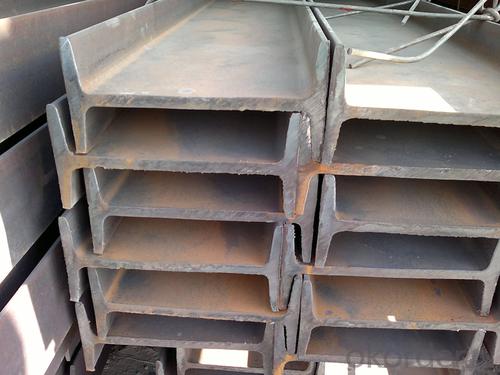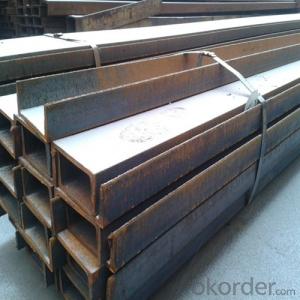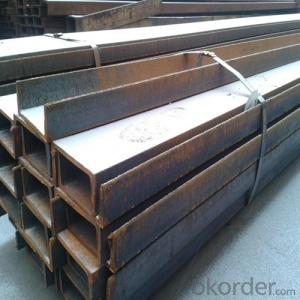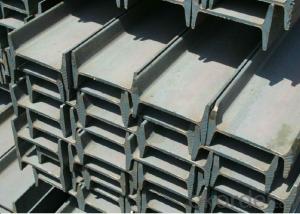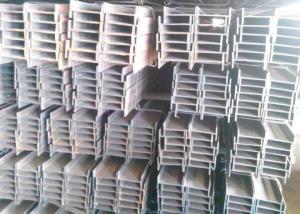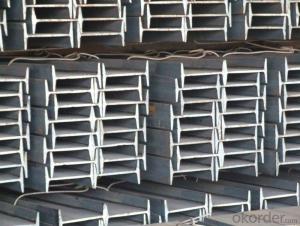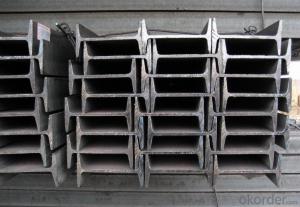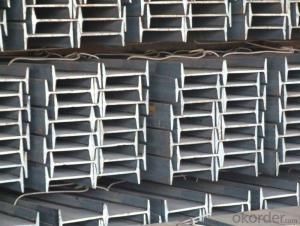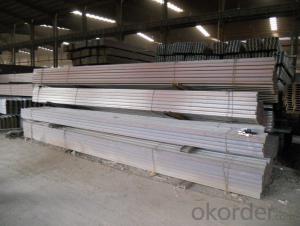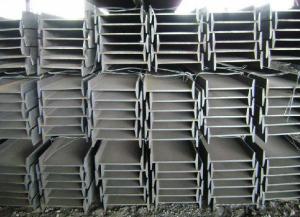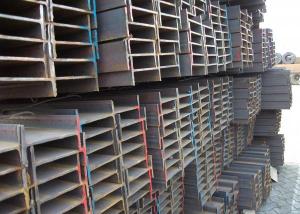Hot Rolled European Standard of I-beam
- Loading Port:
- China Main Port
- Payment Terms:
- TT or LC
- Min Order Qty:
- -
- Supply Capability:
- -
OKorder Service Pledge
OKorder Financial Service
You Might Also Like
Product Description:
OKorder is offering high quality IPEAA Beam at great prices with worldwide shipping. Our supplier is a world-class manufacturer of steel, with our products utilized the world over. OKorder annually supplies products to European, North American and Asian markets. We provide quotations within 24 hours of receiving an inquiry and guarantee competitive prices.
Product Applications:
1. structure construction and electronic tower building construction
2. bridge, trestle, autos, brackets, machinery
3.It is widely used in various building structures and engineering structures such as roof beams, bridges, transmission towers, hoisting machinery and transport machinery, ships, industrial furnaces, reaction tower, container frame and warehouse etc.
Product Advantages:
OKorder's IPEAA Beam are durable, strong, and resist corrosion.
Main Product Features:
· Premium quality
· Prompt delivery & seaworthy packing (30 days after receiving deposit)
· Corrosion resistance
· Can be recycled and reused
· Mill test certification
· Professional Service
· Competitive pricing
Product Specifications:
1.Standard: EN10025, GB Standard
Section | Standard Sectional Dimensions(mm) | ||||
| h | b | s | t | Mass Kg/m |
IPE80 | 80 | 46 | 3.80 | 5.20 | 6.00 |
IPE100 | 100 | 55 | 4.10 | 5.70 | 8.10 |
IPE120 | 120 | 64 | 4.80 | 6.30 | 10.40 |
IPE140 | 140 | 73 | 4.70 | 6.90 | 12.90 |
IPE160 | 160 | 82 | 5.00 | 7.40 | 15.80 |
IPE180 | 180 | 91 | 5.30 | 8.00 | 18.80 |
IPE200 | 200 | 100 | 5.60 | 8.50 | 22.40 |
IPE220 | 220 | 110 | 5.90 | 9.20 | 26.20 |
IPE240 | 240 | 120 | 6.20 | 9.80 | 30.70 |
IPE270 | 270 | 135 | 6.60 | 10.20 | 36.10 |
IPEAA80 | 80 | 46 | 3.20 | 4.20 | 4.95 |
IPEAA100 | 100 | 55 | 3.60 | 4.50 | 6.72 |
IPEAA120 | 120 | 64 | 3.80 | 4.80 | 8.36 |
IPEAA140 | 140 | 73 | 3.80 | 5.20 | 10.05 |
IPEAA160 | 160 | 82 | 4.00 | 5.60 | 12.31 |
IPEAA180 | 180 | 91 | 4.30 | 6.50 | 15.40 |
IPEAA200 | 200 | 100 | 4.50 | 6.70 | 17.95 |
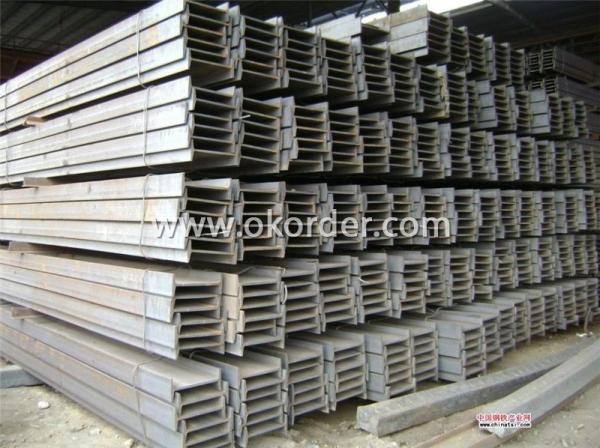
Package & Delivery Terms of IPEAA Beam
1. Packing: it is nude packed in bundles by steel wire rod
2. Bundle weight: not more than 3.5MT for bulk vessel; less than 3 MT for container load
3. Marks:
Color marking: There will be color marking on both end of the bundle for the cargo delivered by bulk vessel. That makes it easily to distinguish at the destination port.
Tag mark: there will be tag mark tied up on the bundles. The information usually including supplier logo and name, product name, made in China, shipping marks and other information request by the customer.
If loading by container the marking is not needed, but we will prepare it as customer request.
4. All the IPEAA Beams will be delivered to the port of Tianjin within 45 days after receiving the Original L/C at sight or the advance payment by T/T.
5. Transportation: the goods are delivered by truck from mill to loading port, the maximum quantity can be loaded is around 40MTs by each truck. If the order quantity cannot reach the full truck loaded, the transportation cost per ton will be little higher than full load.
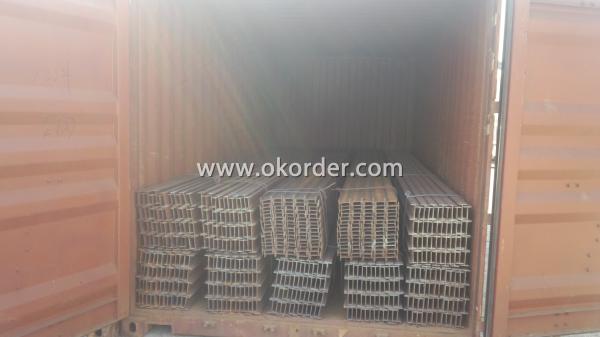
Production Flow of IPEAA Beam
Material prepare (billet) —heat up—rough rolling—precision rolling—cooling—packing—storage and transportation
FAQ:
Q1: Why buy Materials & Equipment from OKorder.com?
A1: All products offered byOKorder.com are carefully selected from China's most reliable manufacturing enterprises. Through its ISO certifications, OKorder.com adheres to the highest standards and a commitment to supply chain safety and customer satisfaction.
Q2: How do we guarantee the quality of our products?
A2: We have established an advanced quality management system which conducts strict quality tests at every step, from raw materials to the final product. At the same time, we provide extensive follow-up service assurances as required.
Q3: How soon can we receive the product after purchase?
A3: Within three days of placing an order, we will begin production. The specific shipping date is dependent upon international and government factors, but is typically 7 to 10 workdays.
- Q: How do I connect two lengths of I-beam?
- A butt weld of 45 degrees is ok. The quality requirement of welding seam is level 1.
- Q: How do steel I-beams resist fire?
- The resistance of fire by Steel I-beams is due to their inherent properties and design features. To begin with, steel possesses a higher melting point in comparison to other construction materials such as wood or concrete. This characteristic allows steel to endure higher temperatures before it starts to weaken or lose its structural integrity. In the case of I-beams, their shape enables an increased surface area, which aids in the efficient dissipation of heat and hinders the rapid spread of fire. Furthermore, steel is a material that does not combust, meaning it does not contribute to the fuel load of a fire. This attribute is crucial for fire safety as it prevents the fire from spreading or intensifying in the vicinity of the I-beams. Moreover, various fire-resistant coatings or fireproofing materials can be applied to protect steel I-beams. These coatings are specifically designed to insulate the steel from high temperatures and fire exposure. They act as a barrier, impeding the transfer of heat to the steel and prolonging the time it takes for the beams to reach critical temperatures. In addition, when designing steel I-beams, fire safety measures are often taken into consideration. These beams are engineered to have sufficient load-bearing capacity even in the event of a fire. This is achieved through measures such as incorporating additional redundancy, including fire protection systems, and employing structural strategies that minimize the impact of thermal expansion. In summary, steel I-beams resist fire due to their high melting point, non-combustible nature, the application of fire-resistant coatings or fireproofing materials, and their consideration of fire safety in their design. These factors work together to ensure that steel I-beams maintain their strength and integrity during a fire, thus enhancing fire safety in buildings and structures.
- Q: What are the different types of steel coatings available for I-beams in renovations?
- When renovating I-beams, there are various steel coatings available, each with its own unique properties and benefits. Some commonly used coatings are: 1. Galvanized Coating: This coating involves applying a layer of zinc to the I-beam surface. It offers excellent corrosion resistance, making it ideal for environments with moisture or harsh conditions. Galvanized coatings also provide good paint adhesion, allowing for additional decorative or protective coatings if desired. 2. Epoxy Coating: Epoxy coatings are popular for their high resistance to chemicals, abrasion, and corrosion. They are applied in multiple layers and require proper surface preparation for optimal adhesion. Epoxy coatings offer excellent durability and can give a smooth and glossy finish. 3. Polyurethane Coating: Polyurethane coatings are known for their exceptional resistance to UV radiation, making them suitable for I-beams exposed to sunlight or outdoor elements. They provide excellent protection against corrosion, abrasion, and chemical exposure. Polyurethane coatings come in various finishes, such as gloss, semi-gloss, or matte, catering to different aesthetic preferences. 4. Powder Coating: This method involves applying a dry powder to the I-beam surface, which is then baked to form a protective and decorative layer. Powder coatings offer excellent durability, impact resistance, and color retention. They come in a wide range of colors and finishes, allowing for customization and aesthetic appeal. Powder coatings also resist corrosion and chemicals. 5. Fire-Resistant Coating: These coatings are specifically designed to protect steel structures, including I-beams, from fire damage. They create an insulating barrier that delays flame spread and maintains the steel's structural integrity. Fire-resistant coatings can be applied as paint or spray and are commonly used in buildings prioritizing fire safety. To determine the most suitable steel coating for I-beams, it's crucial to consider the project's specific requirements and consult with a professional. Factors such as the environment, desired aesthetic, and level of protection needed will help determine the best coating option.
- Q: Can Steel I-Beams be used for soundproofing purposes?
- No, steel I-beams cannot be used for soundproofing purposes. Steel I-beams are primarily used in construction as load-bearing structural elements, providing strength and stability to buildings. While they can help in reducing vibrations and structural noise, they are not effective in blocking or absorbing airborne sound. To achieve soundproofing, specialized materials and techniques are required. Soundproofing typically involves creating barriers or using materials that can absorb, dampen, or deflect sound waves. Common methods include using soundproofing insulation, acoustic panels, double glazing windows, and sealing gaps or cracks. If soundproofing is a concern, it is recommended to consult with professionals or acoustic engineers who can provide guidance and suggest appropriate solutions based on specific needs and requirements.
- Q: How many kilograms can I hold from the window for 2 meters of I-beam?
- I-beam is mainly divided into ordinary I-beam, light I-beam and H steel three. I-steel whether ordinary or light, because the section size are relatively high and narrow, so the moment of inertia of section two of the spindle is larger, so it only can be directly used in the web plane bending member or the composition of lattice stress components. It is not suitable for the axial compression member or the bent member perpendicular to the web plane, which has great limitations in its application. H section steel is a kind of economical and economical surface profile (other cold bending thin wall steel, pressed steel plate, etc.). Because of the reasonable cross-section shape, they can make steel more effective and improve the bearing capacity. Unlike ordinary I-beam, the flange of H steel is widened, and the inner and outer surfaces are usually parallel so that it is easy to connect with high strength bolts and other components. The size of the series is reasonable, the model is complete, easy to design and use.
- Q: Are steel I-beams cost-effective compared to other materials?
- Yes, steel I-beams are generally considered cost-effective compared to other materials. They offer high strength-to-weight ratio, durability, and ease of construction, making them a popular choice in various industries. Additionally, steel is widely available, recyclable, and has a long lifespan, reducing maintenance and replacement costs.
- Q: How do steel I-beams transfer loads and distribute weight in a structure?
- Steel I-beams transfer loads and distribute weight in a structure through their unique shape and structural properties. The vertical web of the I-beam resists shear forces, while the horizontal flanges resist bending moments. This design allows the I-beam to efficiently transfer loads and distribute weight by effectively supporting the structure's weight and any applied loads, ensuring stability and structural integrity.
- Q: Can steel I-beams be used in coastal areas with high humidity?
- Certainly, steel I-beams are suitable for use in coastal regions with elevated humidity. Nevertheless, it is crucial to acknowledge the potential detrimental impact that saltwater and high humidity may have on the steel beams due to corrosion. In such coastal settings, it is imperative to adequately safeguard or cover the steel beams to prevent corrosion. This objective can be accomplished by utilizing corrosion-resistant coatings, such as galvanization or epoxy paint. Furthermore, it is essential to conduct regular inspections and maintenance procedures to detect and rectify any signs of corrosion, while also ensuring the structural stability of the steel beams. By implementing these precautions, steel I-beams can be effectively employed in coastal areas with high humidity.
- Q: What are the considerations for deflection limits in steel I-beam design?
- There are several considerations for deflection limits in steel I-beam design. The first consideration is the structural integrity and stability of the beam. Excessive deflection can compromise the overall strength and safety of the structure. Another consideration is the serviceability of the structure. Excessive deflection can cause discomfort to occupants, affect the functionality of the building, or even lead to damages in non-structural elements such as partitions or finishes. The span of the beam is also an important factor. Longer spans generally require stricter deflection limits to maintain structural integrity and minimize any noticeable deflection. Lastly, the specific application or use of the structure may influence the deflection limits. For example, certain industries or applications may have more stringent deflection requirements due to equipment or operational considerations. Overall, the considerations for deflection limits in steel I-beam design are aimed at ensuring the structural integrity, serviceability, and functionality of the structure while meeting industry standards and requirements.
- Q: How do steel I-beams handle vibrations from nearby railways or highways?
- The exceptional strength and durability of steel I-beams have earned them widespread recognition. This makes them an ideal choice for dealing with vibrations caused by nearby railways or highways. These structures are specifically designed to efficiently distribute loads, including dynamic loads like vibrations, across their entire length. When vibrations occur due to passing trains or heavy traffic, steel I-beams possess various features that help reduce their impact. Firstly, the stiffness and rigidity inherent in steel enable I-beams to effectively absorb and disperse vibrations, thereby minimizing their transmission to the surrounding structure. This is particularly advantageous in situations where sensitive equipment or structures are located in close proximity to railways or highways. Additionally, the configuration of I-beams, with their wide flanges and web, provides structural stability and resistance to bending and twisting forces. This ensures that the beams remain intact and functional even under significant vibrations. The specific design of I-beams also allows for optimal distribution of loads, further decreasing the potential for damage caused by vibrations. Furthermore, steel as a material possesses inherent damping properties, meaning it has the ability to absorb and dissipate energy. This property is advantageous in reducing the amplitude of vibrations that may be transmitted through the I-beams. The combination of steel's damping capabilities and the structural design of I-beams contributes to their effectiveness in handling vibrations from nearby railways or highways. To sum up, steel I-beams are well-suited to handle vibrations from nearby railways or highways due to their stiffness, structural stability, load distribution capabilities, and damping properties. These features work together to ensure that vibrations are effectively absorbed, dispersed, and minimized, thus protecting the integrity and functionality of surrounding structures.
Send your message to us
Hot Rolled European Standard of I-beam
- Loading Port:
- China Main Port
- Payment Terms:
- TT or LC
- Min Order Qty:
- -
- Supply Capability:
- -
OKorder Service Pledge
OKorder Financial Service
Similar products
Hot products
Hot Searches
Related keywords




